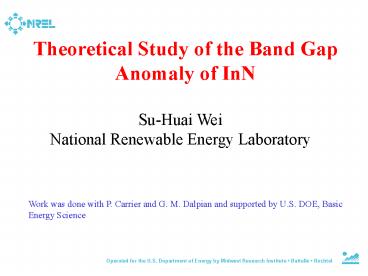Theoretical Study of the Band Gap Anomaly of InN PowerPoint PPT Presentation
1 / 18
Title: Theoretical Study of the Band Gap Anomaly of InN
1
Theoretical Study of the Band Gap Anomaly of InN
Su-Huai Wei National Renewable Energy Laboratory
Work was done with P. Carrier and G. M. Dalpian
and supported by U.S. DOE, Basic Energy Science
2
Theoretical Challenge
- Experimentally measured band gaps of nominal
InN show a wide range of variation from 0.6 eV
to 2.0 eV. - What is the true band gap of pure InN?
- What is the origin of the variation of the
measured band gap?
3
- Theoretical Approach
- The systematic band-structure calculations
are performed using the FLAPW method within the
local density approximation (LDA). - The LDA band gap error is corrected by adding
to the LDA potential a d-like external potential
inside spheres centered at each atomic site a.
- The parameters of the external potential are
fitted first to experimental energy levels only
for AlP, GaP, InP and GaN. The same parameters
are then used to predict the band gaps of all the
other III-V compounds.
4
Predicted Band Gaps
5
Why InN Has a Small Band Gap than InP?
6
Chemical Effects
Due to the large electronegativity, N atom has
much lower s orbital energy than other group V
elements. Due to chemical effect alone
Eg(MN) lt Eg(MP)
7
Volume Deformation Effects
Due to the large electronegativity of N and
relatively large In-N bond lengths, InN has the
smallest deformation potential in III-V
semiconductors Due to deformation potential
effect alone Eg(MN) gt Eg(MP)
8
Why InN Has a Smaller Band Gap than InP
- For most III-V semiconductors, the deformation
potentials are - large, so compound with small atom (GaN) has
larger band gap - than compound with large atom (GaP).
- InN has a very small deformation potential,
therefore, - Eg(InN) lt Eg(InP)
Wei et al., PRB 67, 165209 (2003)
9
Origin of the Measured Large Band Gap of InN
10
Band Structure of InN and GaN
- The conduction band of InN is strongly
non-parabolic!
11
Effects of Non-parabolicity of Bands
- The conduction band effective mass of InN is
a strong function - of Fermi energy or electron carrier
density
12
Effects of Non-parabolicity of Bands
- The a2 is not a linear function of E. The
measured band gap - depends on where the straight lines are
drawn
13
Moss-Burstein Effects
- The absorption edge increases significantly
with the carrier - density, in agreement with recent
experiment J. Wu et al. - PRB66, 201403 (2002)
14
Moss-Burstein Effects
- When InN is highly n-type doped, absorption
within the - conduction band is also possible, that
can even lead to a - negative M-B effects
15
Effects of Oxygen
- The formation of InNxO1-x alloy lowers the
conduction band edge - However, the conduction band of InNxO1-x is
partially occupied, - therefore, the absorption edge increases
significantly due to M-B - effect at x0.03 or n1x1021 cm-3, the
reduction of Eg(0) is - 0.06 eV, but the absorption edge Eg(n)
increased by 1.7 eV
16
Effects of Oxygen
- Formation of ON can induce the formation of
VIn. The band gap - is reduced because ON create a shallow
donor level and VIn - creates a deep acceptor level inside the
gap
17
Effects of Oxygen
- Formation of In2O3 film on InN surface can
lead to a significant - change in the DOS or XPS spectrum.
- Formation of (InN)n/(In2O3)m superlattices
can also increase the - band gap. But the effect is not large.
18
- Summary
- Using a corrected LDAC method, we show that
the band gap of wurtzite InN is about 0.8 0.1
eV, in good agreement with recent experiments. - The small band gap of InN (smaller than InP) is
due to its very small band gap deformation
potential, which is partly due to the high
ionicity of InN. - The possible origin of the measured large band
gap is analyzed in terms of the non-parabolicity
of the bands, the effects of oxygen and the
Moss-Burstein shift. The doping induced M-B shift
has the largest effect on the measured band gap.

